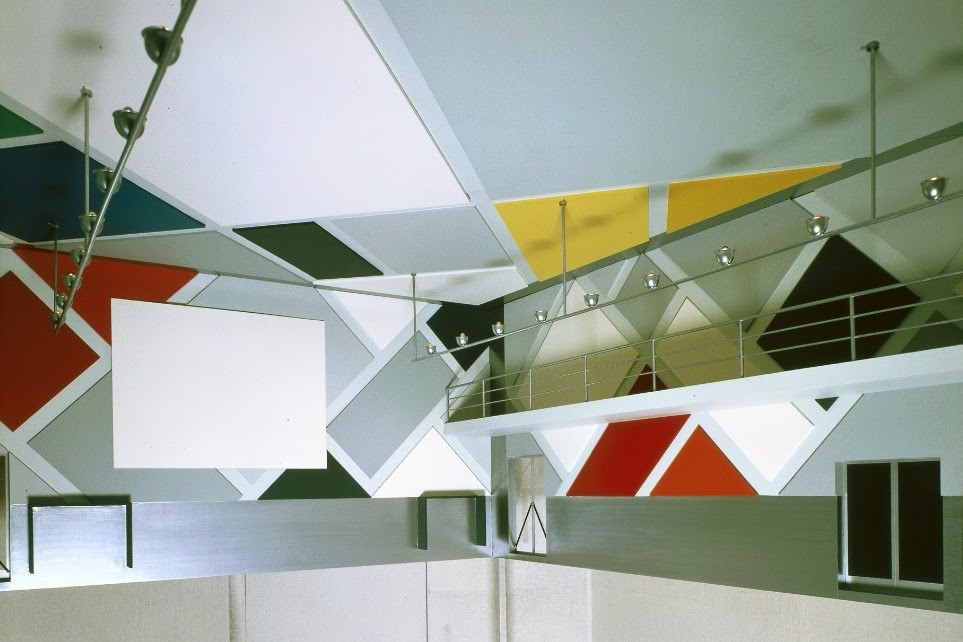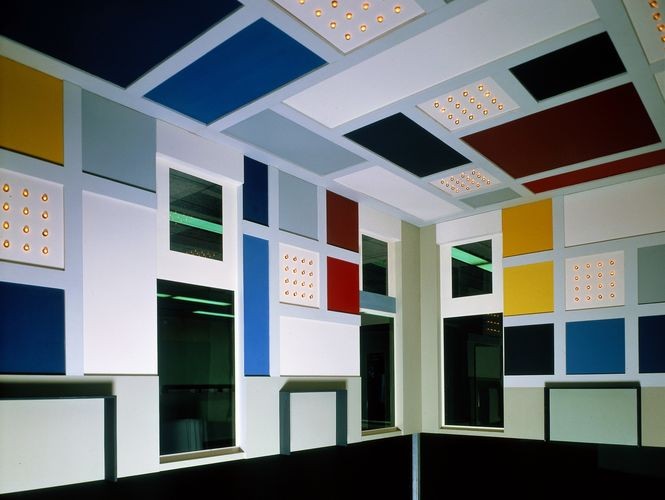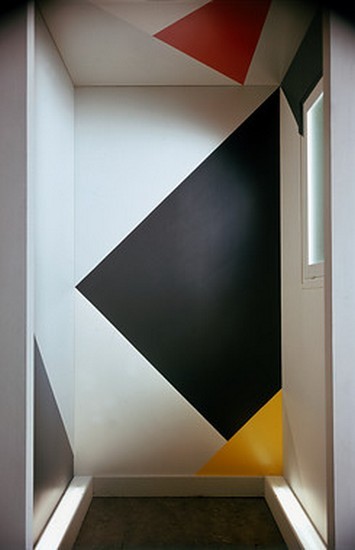Van Abbe And De Stijl
Part of the 'Mondriaan to Dutch Design' year
17 Jun - 31 Dec 2017
VAN ABBE AND DE STIJL
Part of the 'Mondriaan to Dutch Design' year
17 June - 31 December 2017
Curators: Diana Franssen
Van Abbe and De Stijl starts with a major work of De Stijl, looking back at an important moment in its history, and finishing with contemporary works of art and objects which owe their origins to the movement.
The major work is a model of the recreation centre L’Aubette in Strasbourg designed by Theo van Doesburg. It symbolises the seamless fusion of painting and architecture. This model takes us back to Theo van Doesburg’s solo exhibition in the Van Abbemuseum in 1968, for which he made several models based on his architectural ideas.
The 1968 exhibition was a milestone, not only because it rehabilitated Van Doesburg, who it was thought at the time was unjustifiably overshadowed by the painter Piet Mondrian. In the words of the Italian architect and curator Bruno Zevi during his opening address, the exhibition also tried to put a sharp focus on Van Doesburg’s oeuvre and ideas for the future.
In the art movement and the eponymous periodical De Stijl, founded in 1917, the search for essential values in art and in ways of living together had a central place. Van Doesburg saw himself as the focal point of comprehensive innovation in painting, graphic design, architecture and the applied arts. The models and designs exhibited in Van Abbe and De Stijl show that his work is located at the point where literature, art, architecture and design come together.
In the exhibition there is also a clear reference to the future. The vision of Van Doesburg, and more in general of De Stijl, is reflected in the different works of art and objects which were made after De Stijl period. These were added one by one during the course of the thematic year Mondrian to Dutch Design. At the start of the exhibition a reconstruction of a stage design by Piet Mondrian for L'Éphémère est éternel by Michel Seuphor (1926, reconstruction 1964) is part of the exhibition. A contemporary design object was added to this: a cupboard by the Dutch furniture maker Pastoe. This cupboard, entitled “Theo”, is based on the work Compositie XXII (1920) by Theo van Doesburg which is in the Van Abbemuseum collection. The original work can also be seen in the exhibition. The circumstances in which the works of art or objects were created are also highlighted in the exhibition with the use of sketches, notes, letters and photographs, amongst other things. These help to clarify the ideas and views which are held in a specific period, whether this is the 1920s, the 1990s or the present: the individual work of art or object has central place but never stands alone.
2017: THE YEAR FROM MONDRIAAN TO DUTCH DESIGN
In 2017, it will be the 100th anniversary of the foundation of the Dutch artistic movement called ‘De Stijl’ (The Style). Established in 1917 in the Netherlands with founding members Piet Mondrian (born Mondriaan) and Theo van Doesburg, it was originally a magazine, which published Mondrian’s theories on art but it grew into a wider art movement that widely influenced modern architecture, design and fashion. Over the past 25 years, the desire to modernise design and art that characterised De Stijl has been carried forward under the banner of Dutch Design.
To celebrate the anniversarye, NBTC Holland Marketing, together with its partners, has declared 2017 as the year from Mondriaan to Design. Van Abbe and De Stijl is part of the programme in Brabant.
Part of the 'Mondriaan to Dutch Design' year
17 June - 31 December 2017
Curators: Diana Franssen
Van Abbe and De Stijl starts with a major work of De Stijl, looking back at an important moment in its history, and finishing with contemporary works of art and objects which owe their origins to the movement.
The major work is a model of the recreation centre L’Aubette in Strasbourg designed by Theo van Doesburg. It symbolises the seamless fusion of painting and architecture. This model takes us back to Theo van Doesburg’s solo exhibition in the Van Abbemuseum in 1968, for which he made several models based on his architectural ideas.
The 1968 exhibition was a milestone, not only because it rehabilitated Van Doesburg, who it was thought at the time was unjustifiably overshadowed by the painter Piet Mondrian. In the words of the Italian architect and curator Bruno Zevi during his opening address, the exhibition also tried to put a sharp focus on Van Doesburg’s oeuvre and ideas for the future.
In the art movement and the eponymous periodical De Stijl, founded in 1917, the search for essential values in art and in ways of living together had a central place. Van Doesburg saw himself as the focal point of comprehensive innovation in painting, graphic design, architecture and the applied arts. The models and designs exhibited in Van Abbe and De Stijl show that his work is located at the point where literature, art, architecture and design come together.
In the exhibition there is also a clear reference to the future. The vision of Van Doesburg, and more in general of De Stijl, is reflected in the different works of art and objects which were made after De Stijl period. These were added one by one during the course of the thematic year Mondrian to Dutch Design. At the start of the exhibition a reconstruction of a stage design by Piet Mondrian for L'Éphémère est éternel by Michel Seuphor (1926, reconstruction 1964) is part of the exhibition. A contemporary design object was added to this: a cupboard by the Dutch furniture maker Pastoe. This cupboard, entitled “Theo”, is based on the work Compositie XXII (1920) by Theo van Doesburg which is in the Van Abbemuseum collection. The original work can also be seen in the exhibition. The circumstances in which the works of art or objects were created are also highlighted in the exhibition with the use of sketches, notes, letters and photographs, amongst other things. These help to clarify the ideas and views which are held in a specific period, whether this is the 1920s, the 1990s or the present: the individual work of art or object has central place but never stands alone.
2017: THE YEAR FROM MONDRIAAN TO DUTCH DESIGN
In 2017, it will be the 100th anniversary of the foundation of the Dutch artistic movement called ‘De Stijl’ (The Style). Established in 1917 in the Netherlands with founding members Piet Mondrian (born Mondriaan) and Theo van Doesburg, it was originally a magazine, which published Mondrian’s theories on art but it grew into a wider art movement that widely influenced modern architecture, design and fashion. Over the past 25 years, the desire to modernise design and art that characterised De Stijl has been carried forward under the banner of Dutch Design.
To celebrate the anniversarye, NBTC Holland Marketing, together with its partners, has declared 2017 as the year from Mondriaan to Design. Van Abbe and De Stijl is part of the programme in Brabant.



